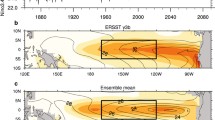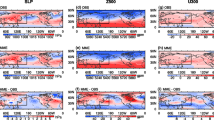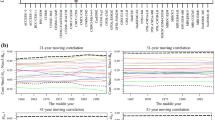Abstract
El Niño–Southern Oscillation (ENSO) is the dominant mode of variability in the coupled ocean-atmospheric system. Future projections of ENSO change under global warming are highly uncertain among models. In this study, the effect of internal variability on ENSO amplitude change in future climate projections is investigated based on a 40-member ensemble from the Community Earth System Model Large Ensemble (CESM-LE) project. A large uncertainty is identified among ensemble members due to internal variability. The inter-member diversity is associated with a zonal dipole pattern of sea surface temperature (SST) change in the mean along the equator, which is similar to the second empirical orthogonal function (EOF) mode of tropical Pacific decadal variability (TPDV) in the unforced control simulation. The uncertainty in CESM-LE is comparable in magnitude to that among models of the Coupled Model Intercomparison Project phase 5 (CMIP5), suggesting the contribution of internal variability to the intermodel uncertainty in ENSO amplitude change. However, the causations between changes in ENSO amplitude and the mean state are distinct between CESM-LE and CMIP5 ensemble. The CESM-LE results indicate that a large ensemble of ~15 members is needed to separate the relative contributions to ENSO amplitude change over the twenty-first century between forced response and internal variability.















Similar content being viewed by others
References
An S-I, Choi J (2015) Why the twenty-first century tropical Pacific trend pattern cannot significantly influence ENSO amplitude? Clim Dyn 44:133–146
Bjerknes J (1969) Atmospheric teleconnections from the equatorial Pacific. Mon Weather Rev 97:163–172
Burgman RJ, Schopf PS, Kirtman BP (2008) Decadal modulation of ENSO in a hybrid coupled model. J Clim 21:5482–5500
Cai W, Borlace S, Lengaigne M, Rensch P, Collins M, Vecchi G, Timmermann A, Santoso A, McPhaden M, Wu L, England M, Wang G-J, Guilyardi E, Jin F-F (2014) Increasing frequency of extreme El Niño events due to greenhouse warming. Nat Clim Change 4:111–116
Cai W et al (2015a) ENSO and greenhouse warming. Nat Clim Change 5:849–859
Cai W, Wang G, Santoso A, McPhaden M, Wu L, Jin F-F, Timmermann A, Collins M, Vecchi G, Lengaigne M, England M, Dommenget D, Takahashi K, Guilyardi E (2015b) More frequent extreme La Niña events under greenhouse warming. Nat Clim Change 5:132–137
Choi J, An SI, Yeh SW, Yu J-Y (2013) ENSO-like and ENSO-induced tropical pacific decadal variability in CGCMs. J Clim 26:1485–1501
Chowdary JS, Xie S-P, Tokinaga H, Okumura YM, Kubota H, Johnson NC, Zheng XT (2012) Inter-decadal variations in ENSO teleconnection to the Indo-western Pacific for 1870–2007. J Clim 25:1722–1744
Collins M, An S-I, Cai W, Ganachaud A, Guilyardi E, Jin F-F, Jochum M, Lengaigne M, Power S, Timmermann A, Vecchi G, Wittenberg A (2010) The impact of global warming on the tropical Pacific Ocean and El Niño. Nat Geosci 3:391–397
Deser C, Phillips AS, Bourdette V, Teng H (2012a) Uncertainty in climate change projections: the role of internal variability. Clim Dyn 38:527–546
Deser C, Knutti R, Solomon S, Phillips AS (2012b) Communication of the role of natural variability in future North American climate. Nat Clim Change 2:775–779
DiNezio PN, Kirtman BP, Clement AS, Lee S-K, Vecchi GA, Wittenberg A (2012) Mean climate controls on the simulated response of ENSO to increasing greenhouse gases. J Clim 25:7399–7420
Fang Y, Chiang JCH, Chang P (2008) Variation of mean sea surface temperature and modulation of El Niño–Southern Oscillation variance during the past 150 years. Geophys Res Lett 35:L14709. doi:10.1029/2008GL033761
Guilyardi E, Wittenberg A, Fedorov A, Collins M, Wang C, Capotondi A, van Oldenborgh GJ, Stockdale T (2009) Understanding El Niño in ocean–atmosphere general circulation models: progress and challenges. Bull Am Meteor Soc 90:325–340
Ham YG, Kug J-S (2016) ENSO amplitude changes due to greenhouse warming in CMIP5: role of mean tropical precipitation in the twentieth century. Geophys Res Lett. doi:10.1002/2015gl066864
Hawkins E, Sutton R (2009) The potential to narrow uncertainty in regional climate predictions. Bull Am Meteor Soc 90:1095–1107
Hawkins E, Sutton R (2012) Time of emergence of climate signals. Geophys Res Lett 39:L01702
Hurrell J et al (2013) The community earth system model: a framework for collaborative research. Bull Am Meteorol Soc 94:1339–1360
Johnson NC, Xie S-P (2010) Changes in the sea surface temperature threshold for tropical convection. Nat Geosci 3:842–845
Kay JE et al (2015) The community earth system model (CESM) large ensemble project: a community resource for studying climate change in the presence of internal climate variability. Bull Am Meteorol Soc 96:1333–1349
Kim S-T, Cai W, Jin F-F, Santoso A, Wu L, Guilyardi E, An S-I (2014) Response of El Niño sea surface temperature variability to greenhouse warming. Nat Clim Change 4:786–790
Li J, Xie S-P, Cook ER, Huang G, D’Arrigo R, Liu F, Ma J, Zheng X-T (2011) Interdecadal modulation of El Niño amplitude during the past millennium. Nat Clim Change 1:114–118
Li J, Xie S-P, Cook ER, Morales M, Christie D, Johnson NC, Chen F, D’Arrigo R, Fowler A, Gou X, Fang K (2013) El Niño modulations over the past seven centuries. Nat Clim Change 3:822–826
Liu Z, Vavrus S, He F, Wen N, Zhong Y (2005) Rethinking tropical ocean response to global warming: the enhanced equatorial warming. J Clim 18:4684–4700
Liu F, Luo Y, Lu Y, Wan X (2016) Response of the tropical Pacific Ocean to El Niño versus global warming. Clim Dyn 48:935–956
Lu J, Zhao B (2012) The role of oceanic feedback in the climate response to doubling CO2. J Clim 25:7544–7563
Luo Y, Lu J, Liu F, Liu W (2015) Understanding the El Niño-like oceanic response in the tropical Pacific to global warming. Clim Dyn 45:1945–1964
Neale RB et al. (2012) Description of the NCAR community atmosphere model (CAM 5.0). NCAR tech note TN-486, pp 274
Ogata T, Xie S-P, Wittenberg A, Sun D-Z (2013) Interdecadal amplitude modulation of El Niño/Southern Oscillation and its impacts on tropical Pacific decadal variability. J Clim 26:7280–7297
Philander SG (1990) El Niño, La Niña and the southern oscillation. Academic Press, San Diego, CA, 293 pp
Power S, Delage F, Chung C, Kociuba G, Keay K (2013) Robust twenty-first-century projections of El Niño and related precipitation variability. Nature 502:541–545
Rashid HA, Hirst AC, Marsland SJ (2016) An atmospheric mechanism for ENSO amplitude changes under an abrupt quadrupling of CO2 concentration in CMIP5 models. Geophys Res Lett 43:1687–1694. doi:10.1002/2015GL066768
Rodgers KB, Friederichs P, Latif M (2004) Tropical Pacific decadal variability and its relation to decadal modulations of ENSO. J Clim 17:3761–3774
Smith TM, Reynolds RW, Peterson TC, Lawrimore J (2008) Improvements to NOAA’s historical merged land–ocean surface temperature analysis (1880–2006). J Clim 21:2283–2296
Smith RD et al (2010) The parallel ocean program (POP) reference manual: ocean component of the community climate system model (CCSM) and community earth system model (CESM). Los Alamos National Laboratory Tech Rep LAUR-10-01853, p 141
Stevenson SL (2012) Significant changes to ENSO strength and impacts in the twenty-first century: results from CMIP5. Geophys Res Lett 39:L17703
Sun F, Yu J-Y (2009) A 10–15-yr modulation cycle of ENSO intensity. J Clim 22:1718–1735
Taylor KE, Stouffer RJ, Meehl GA (2012) An overview of CMIP5 and the experiment design. Bull Am Meteorol Soc 93:485–498
Vecchi GA, Soden BJ (2007) Global warming and the weakening of the tropical circulation. J Clim 20:4316–4340
Watanabe M, Wittenberg AT (2012) A method for disentangling El Niño–mean state interaction. Geophys Res Lett 39:L14702. doi:10.1029/2012GL052013
Watanabe M, Kug J-S, Jin F-F, Collins M, Ohba M, Wittenberg AT (2012) Uncertainty in the ENSO amplitude change from the past to the future. Geophys Res Lett 39:L20703
Wittenberg AT (2002) ENSO response to altered climates. Ph.D. thesis, Princeton University
Wittenberg AT (2009) Are historical records sufficient to constrain ENSO simulations? Geophys Res Lett 36:L12702
Wittenberg AT, Rosati A, Delworth TL, Vecchi GA, Zeng F (2014) ENSO modulation: is it decadally predictable? J Clim 27:2667–2681
Xie S-P, Deser C, Vecchi GA, Ma J, Teng H, Wittenberg AT (2010a) Global warming pattern formation: sea surface temperature and rainfall. J Clim 23:966–986
Xie S-P, Du Y, Huang G, Zheng X-T, Tokinaga H, Hu K, Liu Q (2010b) Decadal shift in El Niño influences on Indo-western Pacific and East Asian climate in the 1970s. J Clim 23:3352–3368
Yeh S-W, Kirtman B (2004) Tropical Pacific decadal variability and ENSO amplitude modulation in a CGCM. J Geophys Res 109:C11009. doi:10.1029/2004JC002442
Yeh S-W, Kirtman B (2007) ENSO amplitude changes due to climate change projections in different coupled models. J Clim 20:203–217
Zheng X-T, Xie S-P, Lv L-H, Zhou Z-Q (2016) Intermodel uncertainty in ENSO amplitude change tied to Pacific ocean warming pattern. J Clim 29:7265–7279
Zhou Z-Q, Xie S-P, Zheng X-T, Liu Q, Wang H (2014) Global warming-induced changes in El Niño teleconnections over the North Pacific and North America. J Clim 27:9050–9064
Acknowledgements
We acknowledge the CESM-LE project for providing model outputs, which may be obtained from http://www.cesm.ucar.edu/projects/community-projects/LENS/data-sets.html. We also acknowledge the World Climate Research Programme’s Working Group on Coupled Modelling, which is responsible for CMIP, and we thank the climate modeling groups (listed in Table 1 of this paper) for producing and making available their model output. We thank Shang-Ping Xie and Qinyu Liu for helpful discussions. This work was supported by the National Basic Research Program of China (2012CB955600 and 2015CB954300), the National Natural Science Foundation of China (41476003), NSFC-Shandong Joint Fund for Marine Science Research Centers (U1406401), and the China Meteorological Public Welfare Scientific Research Project (GYHY201306027).
Author information
Authors and Affiliations
Corresponding author
Appendix: The estimation of the minimum ensemble size N min
Appendix: The estimation of the minimum ensemble size N min
In this study, we evaluate the 95% statistical significance of the ensemble mean changes against a null hypothesis of zero using a one-sample t test. We use the statistic for ensemble mean defined as
where \(\bar {x}\) is the ensemble mean change of ENSO amplitude in a specific 50-year running window relative to that in the first window, \(\sigma\) is the sample standard deviation of the changes in CESM-LE (CMIP5), N is the ensemble size 40 (23),and t(N − 1) is the t statistic for the degrees of freedom N − 1. When \(\bar {x}\) and \(\sigma\) satisfy the following relationship
we can reject the hypothesis and the ensemble mean changes are significant at the 95% confidence level.
According to t-distribution, \(t{(N - 1)_{p=0.05}}\sim 2\) for 2-sided t test (~1.7 for 1-sided t test) when N > ~20. Therefore, we can estimate the minimum ensemble size as\({N_{min}}\sim \frac{4}{{{{\left( {\bar {x}/\sigma } \right)}^2}}}~\) (\({N_{min}}\sim \frac{{2.9}}{{{{\left( {\bar {x}/\sigma } \right)}^2}}}~\)) for 2-sided (1-sided) t test. In this study, we detect the significance of changes in T Niño-3 based on 1-sided t test, while detect the significances of ΔT * Niño-3 and ENSO amplitude changes based on 2-sided t test.
Rights and permissions
About this article
Cite this article
Zheng, XT., Hui, C. & Yeh, SW. Response of ENSO amplitude to global warming in CESM large ensemble: uncertainty due to internal variability. Clim Dyn 50, 4019–4035 (2018). https://doi.org/10.1007/s00382-017-3859-7
Received:
Accepted:
Published:
Issue Date:
DOI: https://doi.org/10.1007/s00382-017-3859-7




